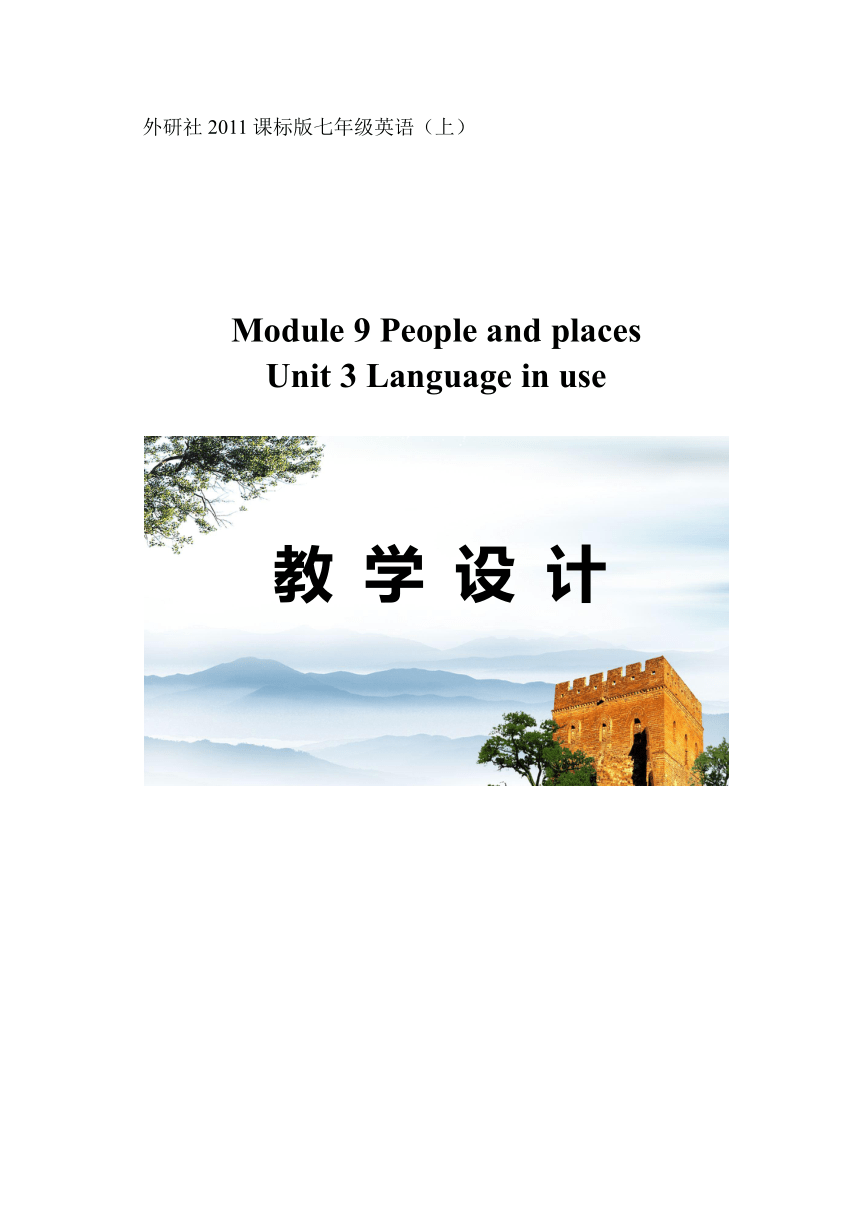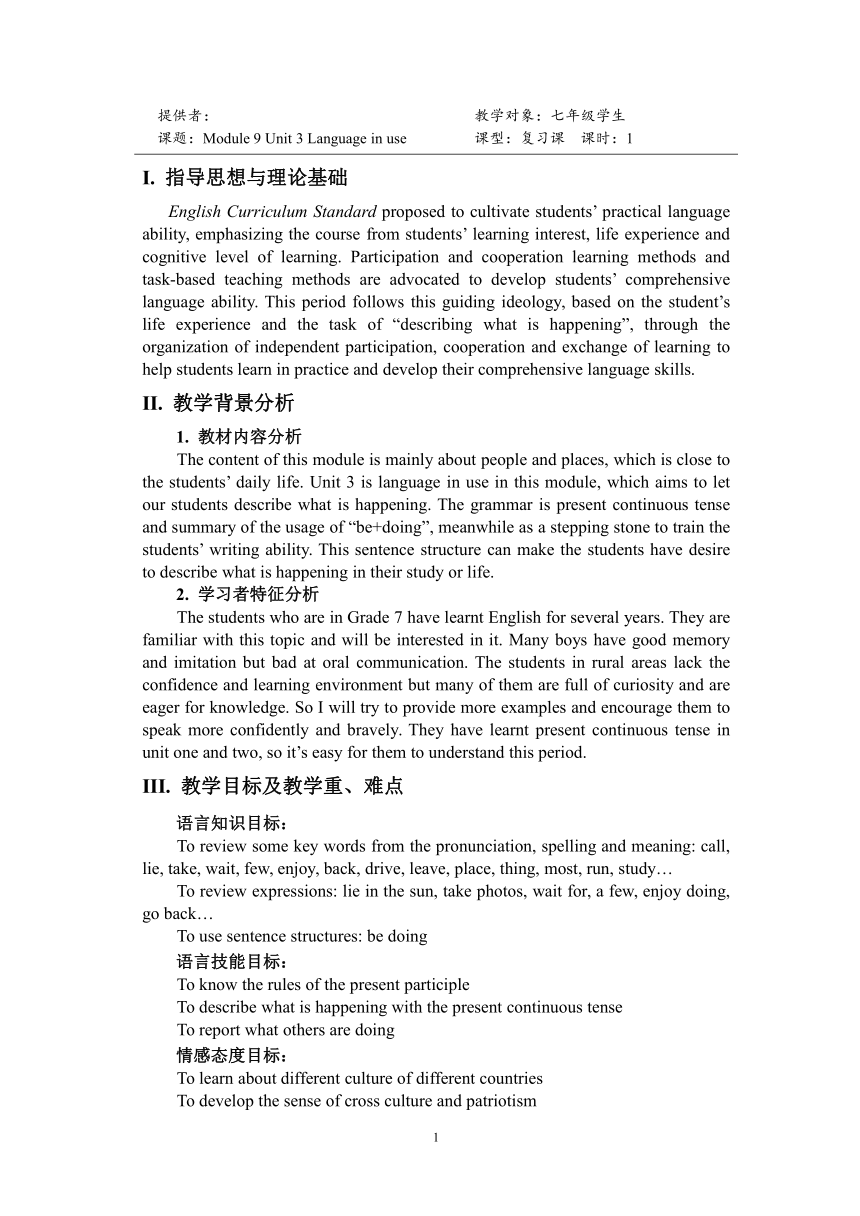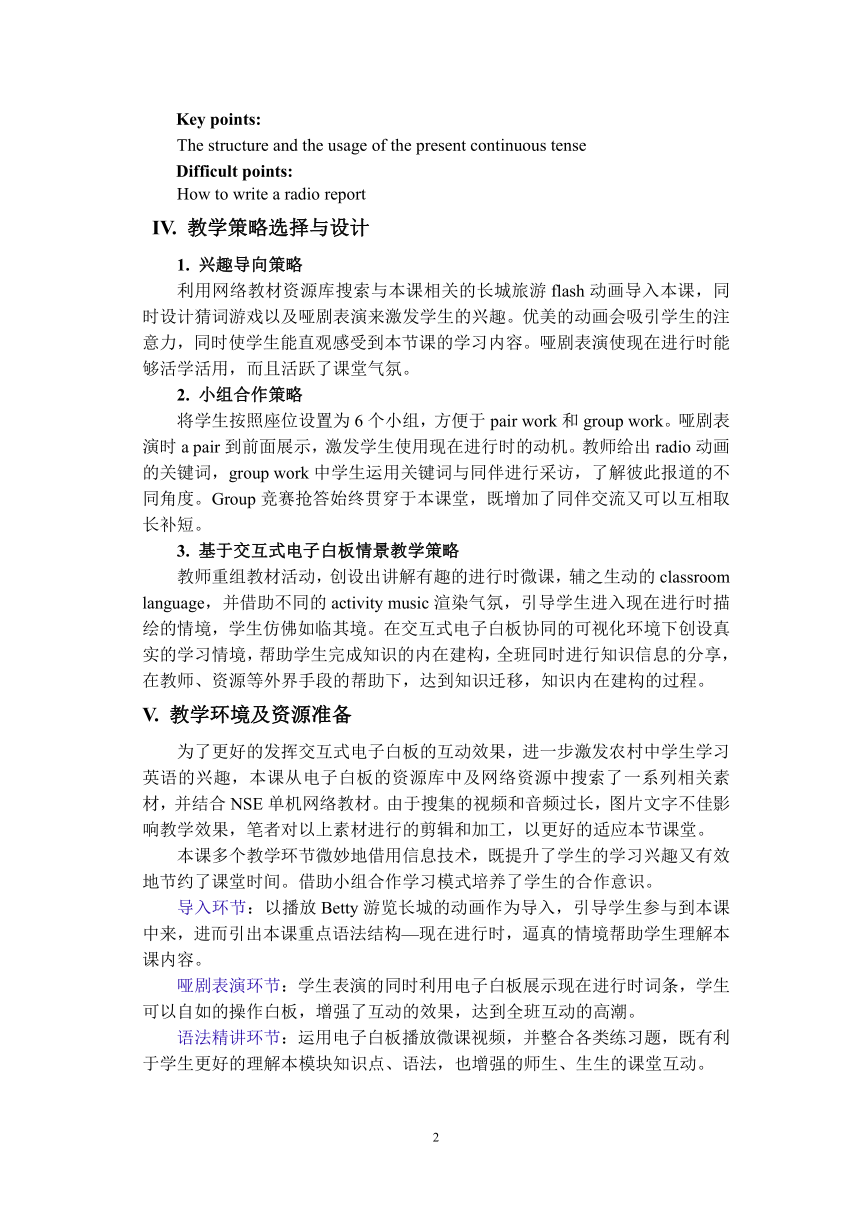外研版英语七年级上Module 9 People and places Unit 3 Language in use.教案(1课时)
文档属性
| 名称 | 外研版英语七年级上Module 9 People and places Unit 3 Language in use.教案(1课时) |

|
|
| 格式 | doc | ||
| 文件大小 | 260.5KB | ||
| 资源类型 | 教案 | ||
| 版本资源 | 外研版 | ||
| 科目 | 英语 | ||
| 更新时间 | 2020-09-24 21:44:39 | ||
图片预览




文档简介
外研社2011课标版七年级英语(上)
Module 9 People and places
Unit 3 Language in use
提供者: 教学对象:七年级学生
课题:Module 9 Unit 3 Language in use 课型:复习课 课时:1
I. 指导思想与理论基础
English Curriculum Standard proposed to cultivate students practical language ability, emphasizing the course from students learning interest, life experience and cognitive level of learning. Participation and cooperation learning methods and task-based teaching methods are advocated to develop students comprehensive language ability. This period follows this guiding ideology, based on the student抯 life experience and the task of 揹escribing what is happening, through the organization of independent participation, cooperation and exchange of learning to help students learn in practice and develop their comprehensive language skills.
II. 教学背景分析
1. 教材内容分析
The content of this module is mainly about people and places, which is close to the students’ daily life. Unit 3 is language in use in this module, which aims to let our students describe what is happening. The grammar is present continuous tense and summary of the usage of 揵e+doing, meanwhile as a stepping stone to train the students writing ability. This sentence structure can make the students have desire to describe what is happening in their study or life.
2. 学习者特征分析
The students who are in Grade 7 have learnt English for several years. They are familiar with this topic and will be interested in it. Many boys have good memory and imitation but bad at oral communication. The students in rural areas lack the confidence and learning environment but many of them are full of curiosity and are eager for knowledge. So I will try to provide more examples and encourage them to speak more confidently and bravely. They have learnt present continuous tense in unit one and two, so it抯 easy for them to understand this period.
III. 教学目标及教学重、难点
语言知识目标:
To review some key words from the pronunciation, spelling and meaning: call, lie, take, wait, few, enjoy, back, drive, leave, place, thing, most, run, study…
To review expressions: lie in the sun, take photos, wait for, a few, enjoy doing, go back…
To use sentence structures: be doing
语言技能目标:
To know the rules of the present participle
To describe what is happening with the present continuous tense
To report what others are doing
情感态度目标:
To learn about different culture of different countries
To develop the sense of cross culture and patriotism
Key points:
The structure and the usage of the present continuous tense
Difficult points:
How to write a radio report
IV. 教学策略选择与设计
1. 兴趣导向策略
利用网络教材资源库搜索与本课相关的长城旅游flash动画导入本课,同时设计猜词游戏以及哑剧表演来激发学生的兴趣。优美的动画会吸引学生的注意力,同时使学生能直观感受到本节课的学习内容。哑剧表演使现在进行时能够活学活用,而且活跃了课堂气氛。
2. 小组合作策略
将学生按照座位设置为6个小组,方便于pair work和group work。哑剧表演时a pair到前面展示,激发学生使用现在进行时的动机。教师给出radio动画的关键词,group work中学生运用关键词与同伴进行采访,了解彼此报道的不同角度。Group竞赛抢答始终贯穿于本课堂,既增加了同伴交流又可以互相取长补短。
3. 基于交互式电子白板情景教学策略
教师重组教材活动,创设出讲解有趣的进行时微课,辅之生动的classroom language,并借助不同的activity music渲染气氛,引导学生进入现在进行时描绘的情境,学生仿佛如临其境。在交互式电子白板协同的可视化环境下创设真实的学习情境,帮助学生完成知识的内在建构,全班同时进行知识信息的分享,在教师、资源等外界手段的帮助下,达到知识迁移,知识内在建构的过程。
V. 教学环境及资源准备
为了更好的发挥交互式电子白板的互动效果,进一步激发农村中学生学习英语的兴趣,本课从电子白板的资源库中及网络资源中搜索了一系列相关素材,并结合NSE单机网络教材。由于搜集的视频和音频过长,图片文字不佳影响教学效果,笔者对以上素材进行的剪辑和加工,以更好的适应本节课堂。
本课多个教学环节微妙地借用信息技术,既提升了学生的学习兴趣又有效地节约了课堂时间。借助小组合作学习模式培养了学生的合作意识。
导入环节:以播放Betty游览长城的动画作为导入,引导学生参与到本课中来,进而引出本课重点语法结构—现在进行时,逼真的情境帮助学生理解本课内容。
哑剧表演环节:学生表演的同时利用电子白板展示现在进行时词条,学生可以自如的操作白板,增强了互动的效果,达到全班互动的高潮。
语法精讲环节:运用电子白板播放微课视频,并整合各类练习题,既有利于学生更好的理解本模块知识点、语法,也增强的师生、生生的课堂互动。
VI. 教学过程
教学步骤 教师活动 学生活动 设计意图及
信息技术
Step 1. Lead in (2min) Show a flash carton of Betty’s school trip to the Great Wall. The students watch the carton and guess what they are going to learn in this period. 通过电子白板播放flash动画,吸引学生注意力并顺利导入本课内容,学生观看动画,回顾本模块所学知识。
Step 2. Vocabulary revision (3min) Review the words by playing the guessing game on the IWB and emphasize the key vocabulary. Try to guess the meaning of the words and match the vocabulary with the pictures as quickly as possible. 展示图片并利用电子白板的聚光灯、批注等功能来复习词汇,可以帮助学生记忆词汇并促进师生更好的互动。
Step 3. Grammar (13min) Play the micro lesson on the IWB and let the ss finish the exercise on it together.
Learn the micro lesson carefully and interact with the teacher. Ask some students to finish the activity 2 and check the answers together. 通过播放微课视频,使学生更好的学习现在进行时,学生可以课后多次观看复习,培养他们的自学能力。活动2充分利用白板的书写功能,树立学生自信心。
Step 4. Exercise (9min) Explain important and difficult language points on the IWB. Design a mime game to practise the present continuous tense. Finish activity 3 and 4, work in pairs, mine an action for your partner to guess by using “be+doing”. 通过练习让学生掌握本课的重点。电子白板的屏幕批注功能被发挥的淋漓尽致。哑剧游戏的设计,让小组竞赛达到高潮。此环节将充分利用电子白板的交互功能进行语言的输出。
Step 5. Expansion (5min) Introduce the time zones of the world in general, and let ss read the “around the world”. Finish the reading and try to talk about the pictures with “be+doing”. Ss can discuss in pairs. 通过查找白板资源库“around the world”拓展知识面,白板展示图片,有利于同学间进行大胆地、自由地交流。
Step 6. Writing (11min) Show a carton about a traffic accident, and show the new vocabulary, let the students take notes of the key information. Try to make notes of the key information and plan a radio report. Write a radio report after discussing in group and show before the class. 白板播放关于交通事故的动画,教师讲解写广播报道的要点及注意事项,小组讨论交流意见后写出报道,并利用实物展台抓拍到白板,使学生们一目了然。
Step7. Homework (2min) 1. Encourage ss to sum up
2. Set homework and conduct moral education:
1. Review the important words and grammar.
2. Rewrite the radio report carefully and hand it in next time.
小组课堂小结后,老师补充重难点,锻炼学生的归纳总结能力。白板展示有关长城名言,借机教师进行情感态度价值观教育。Report训练他们的书面表达能力。
教学流程图
板书设计
VII.教学评价设计
1. 评价方法
教师评价:
本班学生大多是周边农村学生,缺乏学习英语自信心,教师在学生回答问题后要及时反馈,以表扬和鼓励为主,激励学生的学习兴趣,鼓励学生大胆说英语,树立孩子的自信心,让他们在课堂上多表达。
小组互评:
学生之间互相合作及评价,既培养学生的合作意识,也促进彼此互相学习,取长补短。
学生自评:
学生通过评价量表可以看到自己的成绩与不足,找到成功或失败的原因。通过评价使师生互相学习、互相激励、扬长避短,调动教与学双方的积极性,促使师生共同发展。
2. 评价工具
学生评价量表
Assessment items Rating Remark
Classroom behavior — active in class
— understand and respond to the teacher’s instruction
— be cooperative to the partners
Information acquirement - understand the background information of different culture and customs from different countries
- be able to answer the questions about people and places
Abilities - be able to search information on line
- be able to use “be doing”
- be able to talk about what people are doing
- be able to write radio report
Virtues - to develop good sense of cross culture and patriotism
VIII. 本课总结与教学反思
本节课的教学要求对于农村七年级学生来说有一定难度,尤其是动词-ing形式的词尾变化,因此教师在课前精心钻研教材,分析学情,力求设计出切实可行的教学目标,组织行之有效的教学活动,并充分结合信息技术手段,以提高教学实效。总体来说做到了下几点:
1. 遵循传统课堂,注重信息技术创新
作为一节复习课,本节课在遵循传统路线的同时,重视对学生学习策略的培养。首先是复习策略的培养,When you revise your vocabulary, choose words which are useful for you, and write them in sentences. 其次是基于电子白板语法与词汇的完美结合,例如在词汇复习环节,教师通过电子白板的资源库找到与本课相关的图片,利用聚光灯功能进行匹配。再次利用微课复习语法现在进行时,与学生当堂互动。在播放广播报道flash动画的同时,让学生记笔记标出疑难词组,做到“词不离句、句不离境”这样才能充分发挥电子白板的交互功能,为学生创设更好的学习情境。
2. 小组合作学习,小组竞赛贯穿课堂
我所任教的农村学生语言总体水平较差,对英语学习积极性不高。因此在本课中采用小组合作学习的方式,设计了哑剧表演、作文展示等活动,形成了师生、学生与学生之间的全方位、多层次、多角度的交流模式,使小组中每个人都有机会发表自己的观点与看法,也乐于倾听他人的意见。小组竞赛很好的激发学生学习英语的主观能动性,使学生由被动学习变为主动学习,同时也有利于培养学生集体荣誉感和责任感。使学生感受到学英语的乐趣,从而满足了学生的心理需要,促进学生智力因素和非智力因素的和谐发展,最终达到使学生学会、会学、乐学的目标,进而有效地提高了教学效率。
3. 德育渗透,暗中引路
本课的德育渗透没有留下任何做作的痕迹,但它却在暗中指引着每一步的教学设计。大到主要问题的选取,例如:What are you doing now? What is happening? 小到讲解语言点时例子的选取,例如对现在进行时否定句的讲解时,我给出了这样的例子:He isn’t watching TV. He is working on a computer.由于从头至尾对德育的渗透的关注,使得我在最后的summary中引用美国前总统尼克松的话 “只有一个伟大的民族,才能造得出这样一座伟大的长城!”时,学生们给予了充分地认可和积极的回应。
4. 本课的不足
尽管教师做了大量的准备工作,但是本节课仍存在一些问题。比较明显的不足体现在最后的写作活动中,我发现一些学生还不能很有意识地使用所学语言,而更多的关注导学案内容的翻译。这很正常,也很真实。但是如果在今后的教学设计中加强这方面的关注和要求,例如把教学活动设计的尽可能与目标语言贴近,为学生提供更多的操作电子白板的机会并在小组展示时大力赞扬学生对所学语言的使用,这样学生可能会在语言运用方面更加自如。
6
Module 9 People and places
Unit 3 Language in use
提供者: 教学对象:七年级学生
课题:Module 9 Unit 3 Language in use 课型:复习课 课时:1
I. 指导思想与理论基础
English Curriculum Standard proposed to cultivate students practical language ability, emphasizing the course from students learning interest, life experience and cognitive level of learning. Participation and cooperation learning methods and task-based teaching methods are advocated to develop students comprehensive language ability. This period follows this guiding ideology, based on the student抯 life experience and the task of 揹escribing what is happening, through the organization of independent participation, cooperation and exchange of learning to help students learn in practice and develop their comprehensive language skills.
II. 教学背景分析
1. 教材内容分析
The content of this module is mainly about people and places, which is close to the students’ daily life. Unit 3 is language in use in this module, which aims to let our students describe what is happening. The grammar is present continuous tense and summary of the usage of 揵e+doing, meanwhile as a stepping stone to train the students writing ability. This sentence structure can make the students have desire to describe what is happening in their study or life.
2. 学习者特征分析
The students who are in Grade 7 have learnt English for several years. They are familiar with this topic and will be interested in it. Many boys have good memory and imitation but bad at oral communication. The students in rural areas lack the confidence and learning environment but many of them are full of curiosity and are eager for knowledge. So I will try to provide more examples and encourage them to speak more confidently and bravely. They have learnt present continuous tense in unit one and two, so it抯 easy for them to understand this period.
III. 教学目标及教学重、难点
语言知识目标:
To review some key words from the pronunciation, spelling and meaning: call, lie, take, wait, few, enjoy, back, drive, leave, place, thing, most, run, study…
To review expressions: lie in the sun, take photos, wait for, a few, enjoy doing, go back…
To use sentence structures: be doing
语言技能目标:
To know the rules of the present participle
To describe what is happening with the present continuous tense
To report what others are doing
情感态度目标:
To learn about different culture of different countries
To develop the sense of cross culture and patriotism
Key points:
The structure and the usage of the present continuous tense
Difficult points:
How to write a radio report
IV. 教学策略选择与设计
1. 兴趣导向策略
利用网络教材资源库搜索与本课相关的长城旅游flash动画导入本课,同时设计猜词游戏以及哑剧表演来激发学生的兴趣。优美的动画会吸引学生的注意力,同时使学生能直观感受到本节课的学习内容。哑剧表演使现在进行时能够活学活用,而且活跃了课堂气氛。
2. 小组合作策略
将学生按照座位设置为6个小组,方便于pair work和group work。哑剧表演时a pair到前面展示,激发学生使用现在进行时的动机。教师给出radio动画的关键词,group work中学生运用关键词与同伴进行采访,了解彼此报道的不同角度。Group竞赛抢答始终贯穿于本课堂,既增加了同伴交流又可以互相取长补短。
3. 基于交互式电子白板情景教学策略
教师重组教材活动,创设出讲解有趣的进行时微课,辅之生动的classroom language,并借助不同的activity music渲染气氛,引导学生进入现在进行时描绘的情境,学生仿佛如临其境。在交互式电子白板协同的可视化环境下创设真实的学习情境,帮助学生完成知识的内在建构,全班同时进行知识信息的分享,在教师、资源等外界手段的帮助下,达到知识迁移,知识内在建构的过程。
V. 教学环境及资源准备
为了更好的发挥交互式电子白板的互动效果,进一步激发农村中学生学习英语的兴趣,本课从电子白板的资源库中及网络资源中搜索了一系列相关素材,并结合NSE单机网络教材。由于搜集的视频和音频过长,图片文字不佳影响教学效果,笔者对以上素材进行的剪辑和加工,以更好的适应本节课堂。
本课多个教学环节微妙地借用信息技术,既提升了学生的学习兴趣又有效地节约了课堂时间。借助小组合作学习模式培养了学生的合作意识。
导入环节:以播放Betty游览长城的动画作为导入,引导学生参与到本课中来,进而引出本课重点语法结构—现在进行时,逼真的情境帮助学生理解本课内容。
哑剧表演环节:学生表演的同时利用电子白板展示现在进行时词条,学生可以自如的操作白板,增强了互动的效果,达到全班互动的高潮。
语法精讲环节:运用电子白板播放微课视频,并整合各类练习题,既有利于学生更好的理解本模块知识点、语法,也增强的师生、生生的课堂互动。
VI. 教学过程
教学步骤 教师活动 学生活动 设计意图及
信息技术
Step 1. Lead in (2min) Show a flash carton of Betty’s school trip to the Great Wall. The students watch the carton and guess what they are going to learn in this period. 通过电子白板播放flash动画,吸引学生注意力并顺利导入本课内容,学生观看动画,回顾本模块所学知识。
Step 2. Vocabulary revision (3min) Review the words by playing the guessing game on the IWB and emphasize the key vocabulary. Try to guess the meaning of the words and match the vocabulary with the pictures as quickly as possible. 展示图片并利用电子白板的聚光灯、批注等功能来复习词汇,可以帮助学生记忆词汇并促进师生更好的互动。
Step 3. Grammar (13min) Play the micro lesson on the IWB and let the ss finish the exercise on it together.
Learn the micro lesson carefully and interact with the teacher. Ask some students to finish the activity 2 and check the answers together. 通过播放微课视频,使学生更好的学习现在进行时,学生可以课后多次观看复习,培养他们的自学能力。活动2充分利用白板的书写功能,树立学生自信心。
Step 4. Exercise (9min) Explain important and difficult language points on the IWB. Design a mime game to practise the present continuous tense. Finish activity 3 and 4, work in pairs, mine an action for your partner to guess by using “be+doing”. 通过练习让学生掌握本课的重点。电子白板的屏幕批注功能被发挥的淋漓尽致。哑剧游戏的设计,让小组竞赛达到高潮。此环节将充分利用电子白板的交互功能进行语言的输出。
Step 5. Expansion (5min) Introduce the time zones of the world in general, and let ss read the “around the world”. Finish the reading and try to talk about the pictures with “be+doing”. Ss can discuss in pairs. 通过查找白板资源库“around the world”拓展知识面,白板展示图片,有利于同学间进行大胆地、自由地交流。
Step 6. Writing (11min) Show a carton about a traffic accident, and show the new vocabulary, let the students take notes of the key information. Try to make notes of the key information and plan a radio report. Write a radio report after discussing in group and show before the class. 白板播放关于交通事故的动画,教师讲解写广播报道的要点及注意事项,小组讨论交流意见后写出报道,并利用实物展台抓拍到白板,使学生们一目了然。
Step7. Homework (2min) 1. Encourage ss to sum up
2. Set homework and conduct moral education:
1. Review the important words and grammar.
2. Rewrite the radio report carefully and hand it in next time.
小组课堂小结后,老师补充重难点,锻炼学生的归纳总结能力。白板展示有关长城名言,借机教师进行情感态度价值观教育。Report训练他们的书面表达能力。
教学流程图
板书设计
VII.教学评价设计
1. 评价方法
教师评价:
本班学生大多是周边农村学生,缺乏学习英语自信心,教师在学生回答问题后要及时反馈,以表扬和鼓励为主,激励学生的学习兴趣,鼓励学生大胆说英语,树立孩子的自信心,让他们在课堂上多表达。
小组互评:
学生之间互相合作及评价,既培养学生的合作意识,也促进彼此互相学习,取长补短。
学生自评:
学生通过评价量表可以看到自己的成绩与不足,找到成功或失败的原因。通过评价使师生互相学习、互相激励、扬长避短,调动教与学双方的积极性,促使师生共同发展。
2. 评价工具
学生评价量表
Assessment items Rating Remark
Classroom behavior — active in class
— understand and respond to the teacher’s instruction
— be cooperative to the partners
Information acquirement - understand the background information of different culture and customs from different countries
- be able to answer the questions about people and places
Abilities - be able to search information on line
- be able to use “be doing”
- be able to talk about what people are doing
- be able to write radio report
Virtues - to develop good sense of cross culture and patriotism
VIII. 本课总结与教学反思
本节课的教学要求对于农村七年级学生来说有一定难度,尤其是动词-ing形式的词尾变化,因此教师在课前精心钻研教材,分析学情,力求设计出切实可行的教学目标,组织行之有效的教学活动,并充分结合信息技术手段,以提高教学实效。总体来说做到了下几点:
1. 遵循传统课堂,注重信息技术创新
作为一节复习课,本节课在遵循传统路线的同时,重视对学生学习策略的培养。首先是复习策略的培养,When you revise your vocabulary, choose words which are useful for you, and write them in sentences. 其次是基于电子白板语法与词汇的完美结合,例如在词汇复习环节,教师通过电子白板的资源库找到与本课相关的图片,利用聚光灯功能进行匹配。再次利用微课复习语法现在进行时,与学生当堂互动。在播放广播报道flash动画的同时,让学生记笔记标出疑难词组,做到“词不离句、句不离境”这样才能充分发挥电子白板的交互功能,为学生创设更好的学习情境。
2. 小组合作学习,小组竞赛贯穿课堂
我所任教的农村学生语言总体水平较差,对英语学习积极性不高。因此在本课中采用小组合作学习的方式,设计了哑剧表演、作文展示等活动,形成了师生、学生与学生之间的全方位、多层次、多角度的交流模式,使小组中每个人都有机会发表自己的观点与看法,也乐于倾听他人的意见。小组竞赛很好的激发学生学习英语的主观能动性,使学生由被动学习变为主动学习,同时也有利于培养学生集体荣誉感和责任感。使学生感受到学英语的乐趣,从而满足了学生的心理需要,促进学生智力因素和非智力因素的和谐发展,最终达到使学生学会、会学、乐学的目标,进而有效地提高了教学效率。
3. 德育渗透,暗中引路
本课的德育渗透没有留下任何做作的痕迹,但它却在暗中指引着每一步的教学设计。大到主要问题的选取,例如:What are you doing now? What is happening? 小到讲解语言点时例子的选取,例如对现在进行时否定句的讲解时,我给出了这样的例子:He isn’t watching TV. He is working on a computer.由于从头至尾对德育的渗透的关注,使得我在最后的summary中引用美国前总统尼克松的话 “只有一个伟大的民族,才能造得出这样一座伟大的长城!”时,学生们给予了充分地认可和积极的回应。
4. 本课的不足
尽管教师做了大量的准备工作,但是本节课仍存在一些问题。比较明显的不足体现在最后的写作活动中,我发现一些学生还不能很有意识地使用所学语言,而更多的关注导学案内容的翻译。这很正常,也很真实。但是如果在今后的教学设计中加强这方面的关注和要求,例如把教学活动设计的尽可能与目标语言贴近,为学生提供更多的操作电子白板的机会并在小组展示时大力赞扬学生对所学语言的使用,这样学生可能会在语言运用方面更加自如。
6
同课章节目录
- Starte
- Module 1 My teacher and my friends
- Module 2 My English lesson
- Module 3 My English book
- Module 4 My everyday life
- Module 1 My classmates
- Unit 1 Nice to meet you.
- Unit 2 I'm Wang Lingling and I'm thirteen years ol
- Unit 3 Language in use.
- Module 2 My family
- Unit 1 Is this your mum?
- Unit 2 These are my parents.
- Unit 3 Language in use.
- Module 3 My school
- Unit 1 There are thirty students in my class.
- Unit 2 The library is on the left of the playgroun
- Unit 3 Language in use.
- Module 4 Healthy food
- Unit 1 We've got lots of apples.
- Unit 2 Is your food and drink healthy?
- Unit 3 Language in use.
- Module 5 My school day
- Unit 1 I love history.
- Unit 2 We start work at nine o'clock.
- Unit 3 Language in use.
- Revision module A
- Module 6 A trip to the zoo
- Unit 1 Does it eat meat?
- Unit 2 The tiger lives in Asia.
- Unit 3 Language in use.
- Module 7 Computers
- Unit 1 How do I write my homework on the computer?
- Unit 2 When do you use a computer?
- Unit 3 Language in use.
- Module 8 Choosing presents
- Unit 1 I always like birthday parties.
- Unit 2 She often goes to concerts.
- Unit 3 Language in use.
- Module 9 People and places
- Unit 1 We're enjoying the school trip a lot.
- Unit 2 They're waiting for buses or trains.
- Unit 3 Language in use.
- Module 10 Spring Festival
- Unit 1 Are you getting ready for Spring Festival?
- Unit 2 My mother's cleaning our houses and sweepin
- Unit 3 Language in use.
- Revision module B
